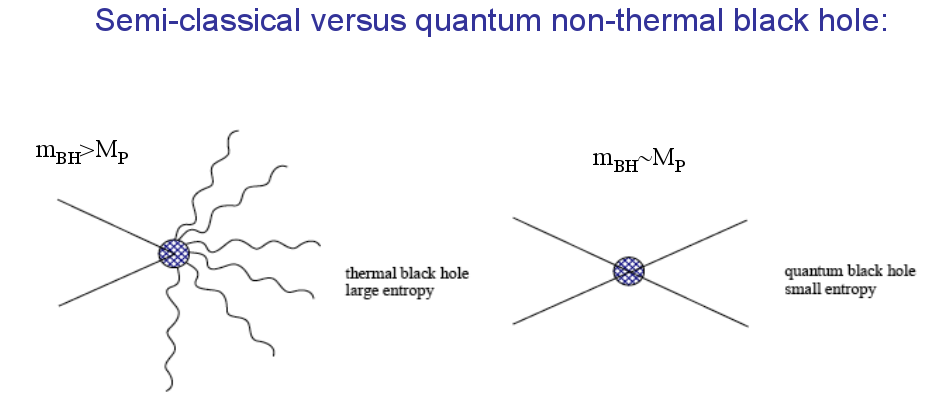|
Xavier Calmet: Working group on quantum black holes (QBHs)
Quantum black holes are black holes with masses close to the Planck mass (i.e. some 1019 GeV). One should make a distinction between semi-classical black holes (i.e. thermal small black holes with masses at least five times larger than the Planck mass) for which reliable calculations can be performed and non-thermal black holes with masses of the order of the Planck mass which belong to the full quantum regime of gravity.

The formation mechanism for semi-classical black holes in collisions of two particles is now very well understood from a theoretical point of view. Furthermore, it is now well appreciated that the Planck mass could be much lower than naively expected if there are large extra-dimensions or if there is large hidden sector of particles next to the Standard Model. In these models, the Planck mass could be as low as a few TeV. In these scenarios, quantum black holes could be produced at colliders. However, semi-classical black holes are too heavy to be produced at the LHC as their masses are out of reach at this collider. On the other hand, small non-thermal black holes could be abundantly produced at the LHC because they are lighter than semi-classical ones. These holes typically decay in only a few particles and the signatures are thus very different from those of semi-classical QBHs which have been extensively studied in the literature. It is thus urgent to get a theoretical handle on non thermal black holes and to study their phenomenology at the LHC. They would offer a unique opportunity to study the symmetries of quantum gravity if they were produced at the LHC.
The aim of this working group is to gather leading experts in the field of quantum gravity both of the theoretical and experimental physics side.
Topics and questions to be covered by this WG:
- to find a theoretical construction to describe in a consistent manner the formation mechanism for small non-thermal black holes.
- Is the mass of quantum black holes quantized or is there a continuous mass spectrum?
- Is it possible to extend the construction for the formation of QBHs in the collision of two particles to three particles? If yes, how does this affect the cross-sections for QBHs at colliders?
- Is the formation mechanism for charged QBHs different than that of neutral QBHs?
- Can we find effective field theories to describe QBHs?
- What can we learn about such a unification using thought experiments involving quantum black holes (e.g. unitarity issues)?
- aim at making predictions for the Large Hadron Collider which could discover the first signals for non-thermal QBHs by the end of 2010 if the Planck mass is around 1 TeV.
- modify the existing event generators to take into account non-thermal black holes.
- can we use cosmological or astrophysical data to probe QBHs and the Planck mass at much higher energies than at the LHC using for example astronomical systems with strong gravitational fields?
Questions to be addressed also include:
- What is the possibility of detecting the primordial BHs evaporating in our Galaxy and close neighbourhood to our Earth?
- What can we learn from Quantum BHs about the physics of the very early Universe?
- How can the problem of evaporation of the primordial BHs be modelled?
- Can Quantum BHs play a key role in the search for a quantum theory of gravity?
- What is the role of BH entropy?
- Is information being lost in BH evaporation?
- What is the emission of gravitons?
- Have Fermi-observations yielded any evidence or constraints for Gamma Ray Burst observations originating in the evaporation from Quantum BHs?
|
